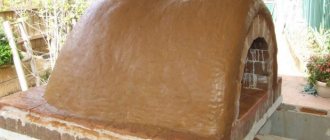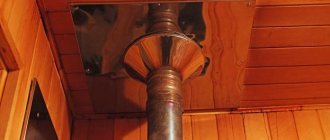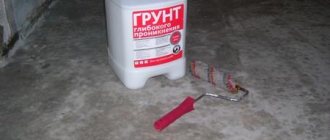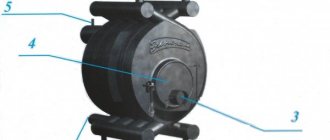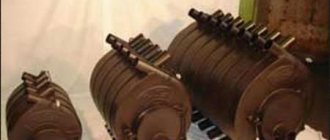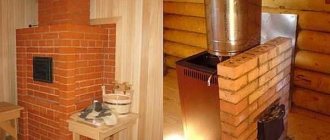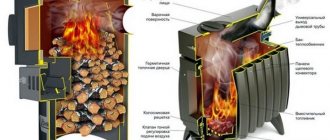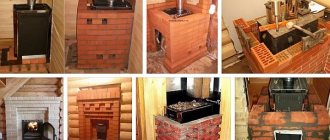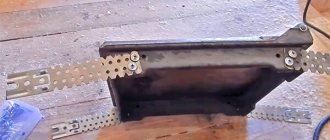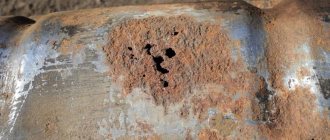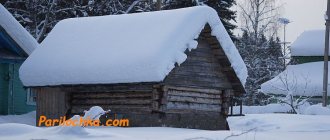Is thermal insulation always necessary?
The need for shielding does not always arise. Spacious baths allow you to install heat sources according to standards. A certain distance between the stove and the walls/occupants makes additional protection unnecessary. But in small family steam rooms, following the norms makes the bath idea impractical - every piece of space is important here.
Figure 2. Examples of furnace locations and the distance between them and insulation
The illustrations show the recommended distance between thermal units and sauna walls. Whatever material the stove is made of, a distance to the opposite wall of at least 1 m is considered safe. But the parameters are “ready” to shrink, provided that a thermal screen is created.
How to protect the walls of a bathhouse from the heat of a stove - technologies and materials
When planning the construction of a bathhouse, it is important to remember to create safety indoors. First of all, this concerns fire safety. By melting the bathhouse, the stove can be heated to 300-400°C, which significantly exceeds the combustion temperature of the wood from which the bathhouse is most often built.
In the bathhouse, it is advisable to use materials that do not support combustion. They are usually called non-flammable. Another requirement: when heated (not burning, but heated), they should not emit harmful substances. This requirement is relevant, since in some rooms of the bathhouse the air temperature under the ceiling can be 100°C or higher.
The stove and chimney are even more dangerous in this regard - here the temperatures are even more significant. Fire safety in these places is ensured by non-combustible materials for the bathhouse. Many were developed specifically for bath regimes; their names in one form or another contain the words “bath” or “sauna”.
Non-flammable materials are needed in the bathhouse
A little about the terms
To avoid confusion about the properties and applications of materials, let's understand the terminology. There are non-flammable materials (NG), low-flammable materials (G1) and simply flammable materials (G2).
Non-combustible materials do not burn under the influence of ignition sources (sparks, open flames, electric discharge, etc.). At all. For example, reinforced concrete, stone, brick and some other building materials.
Weakly (difficultly) combustible materials are incapable of full combustion, however, they burn. These are fiberglass, asphalt concrete, plasterboard, etc.
There are also fireproof and heat-resistant materials. Refractories can withstand exposure to open fire for a long time. They are used in furnaces for furnace lining. In relation to baths, these are fireclay bricks and fireclay masonry mortar. Heat-resistant ones can withstand high temperatures, but they may not be able to withstand open fire.
To ensure that the steam room gains temperature faster and lasts longer, it is often insulated. Moreover, both the walls and the ceiling. As we said, the temperatures are serious, so not all materials can be used. Mineral wool is most often used. It meets fire requirements, however, there are difficulties with humidity: it does not tolerate getting wet. To solve this problem, a layer of vapor barrier is attached on top, which prevents moisture from penetrating inside.
https://www.youtube.com/watch?v=GFwW5QJk5Ys
To prevent the walls from overheating, you can use materials with increased thermal insulation properties and inertness to high temperatures. Two types of materials are used:
- reflective;
- fireproof with lining.
The first type includes materials for wall cladding, consisting of thermal insulation with fire-resistant properties and a metal covering in the form of a sheet.
A protective cake with reflective materials is done this way. First, the thermal insulation is attached using ceramic bushings directly to the wooden walls, then it is sewn up with a stainless steel sheet.
Advice! It is better not to use galvanized metal, since heating may release heavy metals harmful to the human body.
Stainless steel with a polished surface reflects the heat flow inside the steam room, reducing heat loss. In this case, reflected heat is more useful than direct heat. For thermal insulation use:
- basalt cardboard or cotton wool, the only material with increased hygroscopicity, non-flammable, environmentally friendly;
- asbestos cardboard, which reliably protects against flames and has a long service life;
- mineralite, an artificial material made specifically for these purposes.
Protective sheathing requires ventilation gaps of 2 cm from the wall to the insulation, 2 cm from the insulation to the steel sheet. If it is necessary to install the stove as close to the wall as possible, make a double skin of non-combustible insulation, use ceramic bushings to maintain gaps of 2-3 cm and sew them up with a steel sheet.
Measures to protect walls with cladding are necessary in order to preserve the interior decoration of the room. They are more expensive, but no one has canceled the aesthetic advantages of the bathhouse. It is based on tile cladding, which is laid on fire-resistant cladding made of gypsum plasterboard, non-deformable gypsum-based cardboard with fiberglass, mineralite, non-flammable cement-fiber material, moisture-resistant and resistant to biochemical influences, LSU, fiberglass material bound with magnesium additives, resistant to high temperatures, high humidity. Heat-resistant glue is used for installation.
We invite you to familiarize yourself with Bath House Projects (67 photos): one-story options measuring 6x8 under one roof with a garage, two-story bathhouses with an extension and billiards
Advice! Use heat-resistant reinforced Terracotta glue, made from fireclay dust bound with kaolin additives, intended for tiling stoves, fireplaces, and all heated surfaces.
The recommended facing materials are quite varied, the best of them are:
- terracotta tiles, they are made from specially fired clay, which gives increased heat resistance and durability;
- clinker, denser clay tiles with a surface of various colors, similar to facing bricks;
- tiles, also made from clay, having an original embossed surface;
- porcelain stoneware made from a mixture of clays, kaolins, quartz sand, feldspars by high-temperature firing under a pressure of 400-500 kg/cm², with imitation of stone, wood, durable artificial material;
- soap chloride, a rock mineral consisting of talc, magnesite and chlorite, an environmentally friendly natural material that does not absorb moisture at all, has an attractive appearance, does not crumble, and is not afraid of high temperatures.
Advice! Use soap chloride to finish the steam room, this mineral has a healing effect on the human body, regulates blood pressure, stimulates cerebral circulation, expels viruses and microbes due to the release of vitamin D when heated.
All of the listed tiles are an element of protection that forms a cake, the basis of which is a fire-resistant material. Just like a screen, sheet material is installed on ceramic bushings with a gap of 2-3 cm from the wall. The minimum distance to the heat source from the tile should be 20cm.
Protection with cladding decorates the room, creates a positive mood, and helps to increase the efficiency of procedures. And most importantly, properly installed insulation prevents wooden walls from overheating and catching fire. Have a nice steam!
Shielding walls near which stoves are installed
Usually the decoration of bath walls is wooden. It is susceptible to fire and charring. Various heat-resistant materials are used as thermal insulation lining.
Reliable layered cladding with a slight aesthetic effect
If the aesthetics of the cladding is of secondary importance, you can save money and use a combination of metal and heat insulator. First, an insulator is attached to the walls, and a metal sheet is mounted on top. As a starting layer you can use:
- mineralite slabs are fire-resistant panels designed specifically for creating protective screens in saunas and baths;
- basalt cardboard - retaining heat and protecting from fire, it also plays the role of a sound insulator;
- basalt wool is a material characterized by a high degree of fire resistance and hygroscopicity.
Alternatively, you can use asbestos sheets. But they are not environmentally friendly - when heated, they release substances hazardous to health.
Figure 3. Simple thermal lining
The next layer is a sheet of metal. It is better to use stainless steel. An alternative is galvanizing. It is desirable that the sheets are smooth and shiny. The mirror surface reflects infrared rays from the walls. The latter return to the steam room, but having lost their “rigidity” and becoming noticeably safer for humans.
An example of such a protective finish:
- ventilation gap – up to 3 cm;
- heat insulator – up to 2 cm;
- a metal sheet.
In this case, the distance between the insulated wall and the stove is at least 40 cm. To ensure thermal gaps, the insulation is mounted using ceramic bushings.
Figure 4. Layout of thermal insulation elements
Recommendation! If the distance between the heat source and the wall is close to the standard minimum, it is better to make double-layer thermal insulation. In this case, the gaps between layers of wool, mineralite or alternative material are similar - up to 3 cm.
Decorative protective cladding
The use of a combination of thermal insulation and metal meets functional needs, but not aesthetic ones. In an expensive bath interior, such a combination is unacceptable. In this case, the role of the crowning layer is played by heat-resistant ceramic tiles.
Suitable ceramics for finishing:
- porcelain stoneware; the most durable and dense option; the material is also called artificial stone - there are many types that can imitate wood, stone, metal, etc.;
- clinker; a popular oven option, characterized by high density and a variety of shades;
- terracotta tiles; similar to clinker, but less durable; Available in both matte and enameled formats;
- tiles; ceramics, which in the past were most often used to decorate stoves by wealthy bathhouse owners; the main feature of the tile is the box-shaped back part, due to which high heat transfer is formed;
- soapchlorite; rock slabs; characterized by greenish and grayish tints.
Figure 5. Ceramic thermal protection
Heat-resistant ceramics are laid on heat-resistant tile adhesive.
But even here you can’t do without insulation. If you cover a wooden wall directly with slabs, the latter will receive a significant “portion” of heat, and this is fraught with, at a minimum, charring. Therefore, ceramics is the final layer, under which any of the already known thermal materials are mounted. To the insulators described above, you can add fireproof plasterboard and glass-magnesium sheet. Both options protect well from the negative effects of high temperatures, and LSU is also moisture resistant.
Protecting the walls of the bathhouse from the heat of the stove: rules for constructing protective screens and casings
During the heating of the bath, the surface of the stove heats up to 300-400°C. At the same time, it begins to emit infrared rays and itself becomes a source of heating. The coming heat is distributed throughout the steam room, but first of all it hits the walls adjacent to the stove. If the walls are wooden, then under the influence of high temperatures their charring begins.
The need to install protective casings and screens does not always arise. If a fire-safe distance is maintained between the stove and the nearest flammable surface, additional protection is not needed. At this distance, the IR rays are scattered, weakened, and the amount of them that the wooden wall receives can no longer lead to damage.
It is believed that the safe distance from the wall to the brick stove (quarter-brick laying) is at least 0.32 m, from the wall to the metal stove (not lined) - at least 1 m. For a metal stove lined from the inside with brick or fireclay, the distance decreases to 0.7 m.
Thus, maintaining fire safety distances is more possible in large baths, where the issue of saving space is not relevant. In family steam rooms, where every centimeter of space counts, installing a stove 0.3-1 m from the nearest walls is impractical. In this case, the safety distances established by the standards must be reduced using screens and casings.
Protective screens are insulation panels that cover the side surfaces of the furnace and reduce the intensity of thermal radiation. Screens can be metal or brick. As a rule, they are used for metal furnaces.
The most common protective screens are factory-made steel or cast iron sheets. They are installed around the stove, at a distance of 1-5 cm from the walls of the firebox. Depending on the need to insulate one side or another of the furnace, you can purchase side or front (front) screens. Many metal furnaces are initially manufactured with protective screens in the form of a protective casing.
Protective screens make it possible to reduce the temperature of external metal surfaces to 80-100°C and, accordingly, reduce the fireproof distance to 50 cm. The total distance from the firebox to the wall (including a gap of 1-5 cm) will be 51-55 cm.
Installing protective screens is not difficult. Thanks to the presence of legs, metal panels are easily bolted to the floor.
A brick screen can cover all the side surfaces of a metal furnace, representing its outer cladding. Then the stove will be in a casing made of brickwork. In another case, a brick screen is a wall separating the stove and the flammable surface.
To lay the protective screen, solid fireclay bricks are used. The binder is cement or clay mortar. It is recommended to use half a brick (thickness 120 mm). But, if there is a lack of material, it is possible to make a wall of a quarter of a brick (60 mm thick), although in this case the thermal insulation properties of the screen will be reduced by half.
Small openings (sometimes with fire doors) are left at the bottom of the shield for air convection between the brick wall and the stove.
The brick walls of the screen must end at least 20 cm above the top surface of the oven. Sometimes the masonry goes all the way to the ceiling.
The brick screen is not installed flush against the walls of the stove, the optimal distance is 5-15 cm. The acceptable distance from the brickwork to the flammable wall is 5-15 cm. Thus, the use of a brick screen allows you to reduce the distance from the stove to the wooden wall to 22-42 cm (stove - ventilation gap 5-15 cm - brick 12 cm - ventilation gap 5-15 cm - wall).
Walls adjacent to the hot furnace walls are susceptible to spontaneous combustion. To prevent their overheating, special casings consisting of heat-insulating and non-combustible materials are used.
Sheathing consisting of a combination of non-combustible insulation and metal sheets is effective. In this case, thermal insulation is attached to the wooden surface, which is covered with a stainless steel sheet on top. Some use galvanizing for these purposes, but, according to some data, when heated, it can release harmful substances. It’s better not to risk it and buy a stainless steel sheet.
For greater efficiency, the metal sheet of the screen must be well polished. The mirror surface helps to reflect heat rays from the wooden surface and, accordingly, prevents its heating. In addition, a stainless steel sheet, directing IR rays back into the steam room, transforms hard radiation into softer radiation, better perceived by humans.
The following can be fixed under stainless steel as thermal insulation:
- Basalt wool - it has high thermal insulation properties and is absolutely safe when used in a bathhouse. It has increased hygroscopicity and does not burn.
- Basalt cardboard is thin sheets of basalt fiber. Used as a fireproof, sound and heat insulating material.
- Asbestos cardboard is a sheet fire-resistant heat insulator. It has high strength and durability, protects flammable surfaces from ignition.
- Minerite is a non-flammable sheet (plate) specially manufactured for shielding stoves, fireplaces, and easily flammable surfaces in baths and saunas.
A popular example of cladding using a metal sheet is this “pie”: wall – ventilation gap (2-3 cm) – insulation (1-2 cm) – stainless steel sheet. The distance from the wooden wall to the stove is at least 38 cm (SNiP 41-01-2003).
We invite you to familiarize yourself with Frame bathhouse pros and cons
Ceramic bushings are used to attach the sheathing to the wall. They do not heat up and allow the formation of ventilation gaps between the thermal insulation and the wall.
If the distance between the wooden wall and the stove is minimal, then the cladding is made of two layers of fire-resistant insulation, for example, mineralite. In this case, the sheets are fixed through ceramic bushings, maintaining a gap of 2-3 cm. The top sheet is covered with stainless steel.
Of course, protective cladding with stainless steel perfectly protects wooden walls from heat and fire. But it can spoil the impression of the most expensive finish. Therefore, if the steam room is designed in a decorative style, the fire-resistant lining is masked with heat-resistant tiles. The tiles are laid on heat-resistant adhesive, for example, produced by Terracotta.
The best materials for cladding walls near the stove:
- Terracotta tiles are made from baked clay. It is characterized by strength, heat resistance, durability. Terracotta tiles can be matte or glazed (majolica), and the color varies from pastel yellow to brick red.
- Clinker tiles are also made of clay and look similar to facing bricks. Unlike terracotta, clinker tiles are denser. The color range covers almost all colors, ranging from white to black, including green and blue tones, unusual for clay.
- Tiles are a type of ceramic tile. It usually has embossing on the front surface in the form of a design or ornament.
- Porcelain tiles are heat-resistant, durable tiles. Depending on the method of processing the front surface, tiles can imitate natural stone, brick, or wood. The color range includes all natural shades, from white to black.
- Soapstone is a rock of grayish or greenish color. It is fireproof, waterproof and durable.
Attaching fire-resistant tiles directly to walls will not have any thermal insulation effect. The wall will still heat up, which can lead to spontaneous combustion. Therefore, tiles are used only as an element of a protective “pie” of the following design: wall – ventilation gap (2-3 cm) – fire-resistant sheet material – tiles. It is recommended to maintain a minimum distance of 15-20 cm from the tiles to the walls of the oven.
Any material from this list can be used as a fire-resistant element in the cladding:
- Fire-resistant drywall (GKLO) is drywall supplemented with fiberglass fibers. Resists thermal effects without structural deformation.
- Minerite is a cement-fiber board, absolutely non-flammable. Minerite slabs are moisture resistant, do not rot, and do not decompose.
- Glass-magnesium sheet (FMS) is a material in the form of plates made on the basis of magnesium binder and fiberglass. It has heat and sound insulating properties and is not destroyed by water and temperature changes.
The protective cladding, which must comply with the ventilation gap, has a very low heat absorption coefficient, so the wall underneath it practically does not heat up. In addition, the use of cladding allows you to disguise the protective “pie” and maintain the finishing of the steam room in the same style.
Reliable insulation of the stove in a bathhouse from the walls is one of the most basic tasks in building a bathhouse. Protecting flammable surfaces avoids not only fire, but also deformation of the wall material. It is important for home craftsmen to know the basic requirements and step-by-step instructions for working on thermal insulation from various materials.
First, let's figure out whether it is always necessary to protect the surfaces of walls and ceilings in a bathhouse.
If the stove is made of brick, or is located at a distance of more than 1000 mm from the wall, it does not make sense to carry out a full cycle of thermal insulation work. In these cases, it is enough to make a protective screen from foil on moisture-resistant kraft paper. It is important to know the gaps between the wall and stoves with different surface materials:
- it is recommended to move the stove, laid out with a wall thickness of half a brick, 350-400 mm from the surfaces of the bathhouse;
- a metal stove, not lined with brick or a layer of thermal insulation, must be at least 1000 mm away from the walls;
- It is recommended to install a steel stove with an extended part of the firebox and protected by thermal insulation at a distance of 700 mm.
But most individual baths are small in size and it is not always possible to maintain the required clearances. Therefore, the optimal solution to the problem is to protect the walls and ceiling with a reliable layer of thermal insulation made of non-flammable, moisture-resistant materials.
Example of wall protection
SNIP requirements
Protection of the walls of the bathhouse from the heat of the stove is carried out in accordance with the requirements of building codes. It is important for a home master to know the main ones.
SNiP III-G.11-62
Furnace shielding
You can also provide protection from heat radiation with a screen around or near the stove. Insulation can be brick or metal.
Brick shielding
Bricks can be used to protect either one of the stove sides or all three - the sides and the back. In the latter case, essentially a brick casing is formed.
Bricks are placed maintaining a distance between the stove walls. Recommended distance is 5-10 cm. Approximate diagram of the protection device:
- ventilation gap – 5-10 cm;
- brick – 6-12 cm (depending on the format of the masonry);
- ventilation gap – 5-10 cm;
- bake.
Figure 6. Brick screening
Fireclay bricks are usually used as a screen. It is distinguished by optimal thermal characteristics. It is advisable to lay it in half a brick (12 cm), but if you increase the intervals between the walls and the stove, laying it in a quarter of a brick is allowed. Fireclay is placed on clay (or cement-clay) mortar or on a special heat-resistant masonry mixture.
Convection holes are formed at the bottom of the screen. Sometimes they are made in other areas of the shielding wall. To regulate air circulation, holes are made with doors.
Important! The brick must vertically overlap the stove by at least 20-30 cm
Metal shielding
This is the most popular option, characterized by availability and fast execution. There is a need for metal if factory furnaces are not initially equipped with thermal protection.
Most often, cast iron or steel sheets play the role of insulation in bathhouses. They are mounted around the hearth, maintaining a distance of 1-5 cm. If there is no thermal insulation of the factory stove in the bathhouse, the fireplace is equipped with either front or side sheets. The type of screen depends on the location and design of the furnace.
Figure 7. Metal furnace screen
Such shielding makes it possible to reduce the temperature of the stove surface to 100 degrees and below. This, in turn, makes it possible to reduce the standard distance between the heat source and the opposite wall by half - to half a meter.
Do not forget! The floor also needs protection. The larger the oven, the stronger the foundation should be. And if the floor is wooden, it is thermally insulated in the same way - using a heat insulator and an outer layer (metal, brick, tile)
Protective thermal screens
As the main protection of the walls of the bathhouse, heat-resistant screens are used - special insulation shields to cover the side surfaces of the stove and reduce the intensity of the spread of IR radiation in the room.
Screens are divided into two categories: metal and brick.
Metal
Protective screen made of sheets of steel or cast iron. It is mounted around the perimeter of the sauna stove, while maintaining small technological gaps (3-5 cm) between the screen and the outer walls of the heating structure to ensure additional air convection.
Depending on the characteristics of the walls of the bathhouse and the type of stove, metal screens can be front and side. Some models of metal stoves are produced with an additional protective casing, which is installed when installing the firebox.
Installation of metal screens is carried out using adjustable legs and secured to the floor with bolts. In addition, the legs allow for clearance at the bottom of the structure for additional ventilation. To increase service life, the screens are coated with a fire-resistant paint layer.
Advantages:
- reduction in the intensity of IR rays;
- improvement of air convection between the oven walls and the screen;
- reduction of the overall heating temperature of the external walls of the heating structure.
Brick
A protective screen made of brick is intended for enclosing the walls of a sauna stove.
The masonry is done in ½ brick around the perimeter, maintaining technological gaps of 6 cm. The lower part of the structure is equipped with additional air ducts at a distance of 2.5 cm from each other.
To construct a brick screen for furnaces, heat-resistant fireclay bricks without voids are used. As a connecting mixture - a thick solution of cement or clay.
The finished screen walls should be 22–25 cm higher than the wall of the heating structure.
Advantages:
- low thermal conductivity of the material from which the screen is made;
- resistance to high humidity and high temperatures;
- long-term accumulation of heat in the room;
- receiving soft heat from the stove.
When is this required?
There are times when there is no need to protect walls. If the stove is located at a safe distance from the wall from a fire safety point of view, the installation of protective screens and other measures can be neglected. The distance from the walls that is required to reduce the heat from the source varies:
- A stove laid in a quarter of a brick should be located no closer than 35-40 cm from the wall;
- A metal stove without lining should be placed a meter away and no closer;
- A metal one with a lined furnace can be installed 70-75cm from the wall.
However, not every steam room has the opportunity to fulfill these requirements, due to the small area. The layout of steam rooms with an area of 6-8 m² can hardly accommodate the necessary set of items for the steaming procedure. Therefore, the need to insulate walls with special sheathing is relevant.
Tags: bathhouse, heat, protection, stove, wall
« Previous entry
Protecting a wooden wall from the heat of a stove
Wooden baths require especially careful compliance with fire safety rules when arranging them. The source of the fire can be anything, an unextinguished cigarette, coals falling from the furnace of the firebox, an uncleaned chimney, but the main source of threat remains the stove itself.
The surface of the stove heats up to 300° - 400°, the heat falls on the wooden walls, which leads to their excessive heating and charring. It is extremely difficult to stop the process of ignition of wooden surfaces; the best way to avoid a fire is to prevent it. There are two truly effective ways to insulate the surface of wooden walls from the heat of sauna stoves - protective equipment in the form of a screen or the construction of special cladding from non-combustible materials.
There are times when there is no need to protect walls. If the stove is located at a safe distance from the wall from a fire safety point of view, the installation of protective screens and other measures can be neglected. The distance from the walls that is required to reduce the heat from the source varies:
- A stove laid in a quarter of a brick should be located no closer than 35-40 cm from the wall;
- A metal stove without lining should be placed a meter away and no closer;
- A metal one with a lined furnace can be installed 70-75cm from the wall.
However, not every steam room has the opportunity to fulfill these requirements, due to the small area. The layout of steam rooms with an area of 6-8 m² can hardly accommodate the necessary set of items for the steaming procedure. Therefore, the need to insulate walls with special sheathing is relevant.
Screens are shields made of brick or metal that protect walls from intense thermal radiation. Similar protection is used when installing metal stoves.
- Metal screens are made from steel or cast iron sheets, these
casings surround the heat source with a distance of 3-5cm.
Advice! When purchasing a metal sauna stove, you should give preference to a model equipped with a metal casing. Its cost is not much higher, but the issues of wall insulation are eliminated.
Additional frontal or front shielding, which is located on the walls depending on the location of the stove, will not hurt. The protection guarantees the wood from overheating, reducing the temperature by 100 degrees or more, and provides the opportunity to save space in the steam room. A stove protected by a casing can be installed at a distance of 50-55cm from the wall.
Installation of screens is simple. The casing, equipped with legs, is secured to the floor by side or front screens - with galvanized nails or self-tapping screws.
- Brick screens are masonry used to cover the stove with
on all sides, the same casing, only made of brick. Another method is to lay half a brick between the firebox and a wall made of solid fireclay bricks laid on a solution of clay and cement. The width of the wall should be 120mm, although there is an opinion that it is permissible to put 60mm in a quarter of a brick, but it should be remembered that in this case the thermal insulation value is reduced by exactly half. It is recommended to raise the height of the masonry 20-30 cm above the surface of the firebox, but if you raise it to the ceiling, it will not be worse.
The screen should be placed at a distance of 10-15cm from the wall, 5-15cm from the stove, that is, the space saving is 30-40cm
Important! Functional openings for heat exchange should be made in the lower part of the masonry.
Protective screens are effective; they reduce the temperature to a level acceptable when using high-temperature fuel units. The same function is performed by wall cladding made of non-combustible materials.
